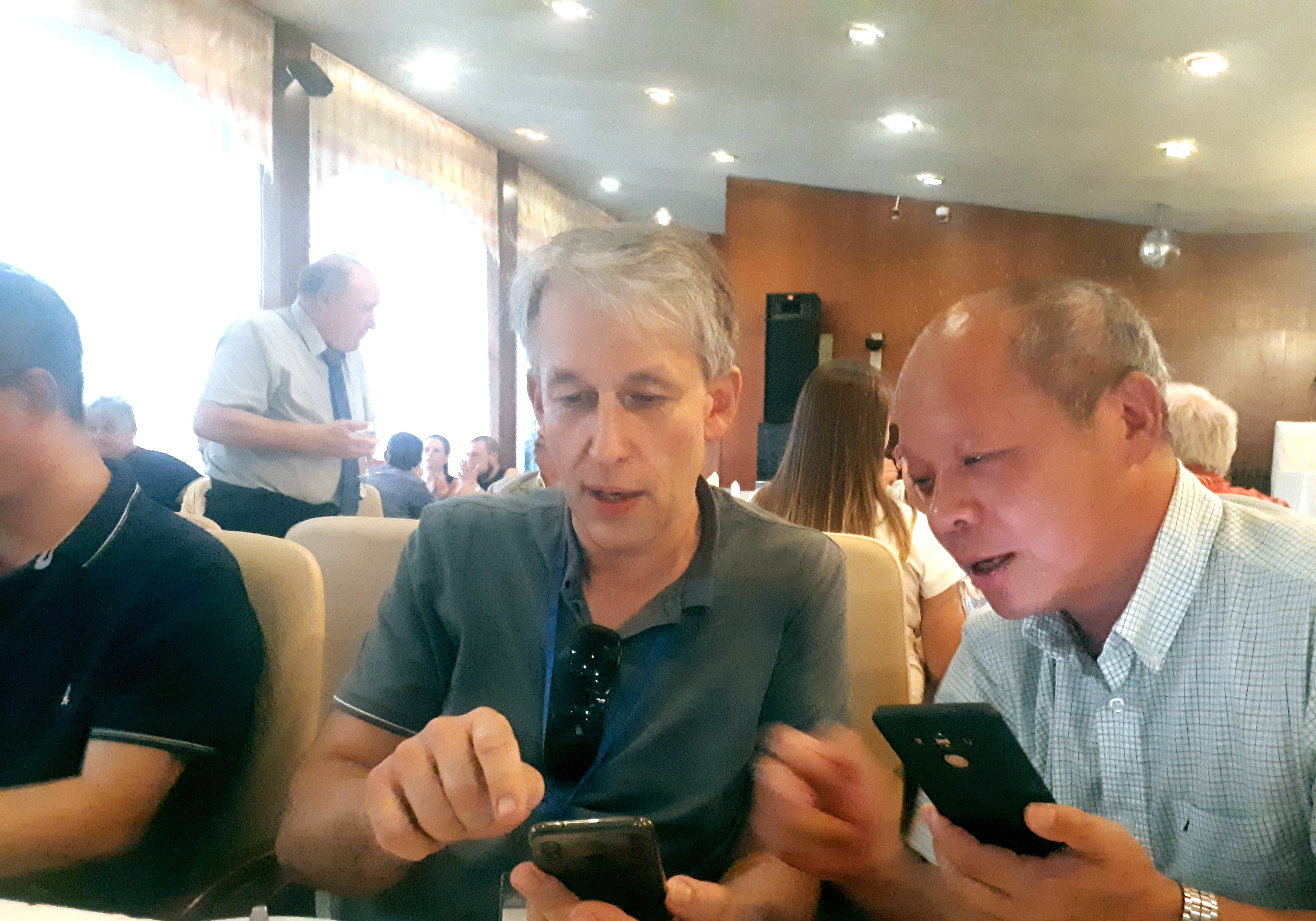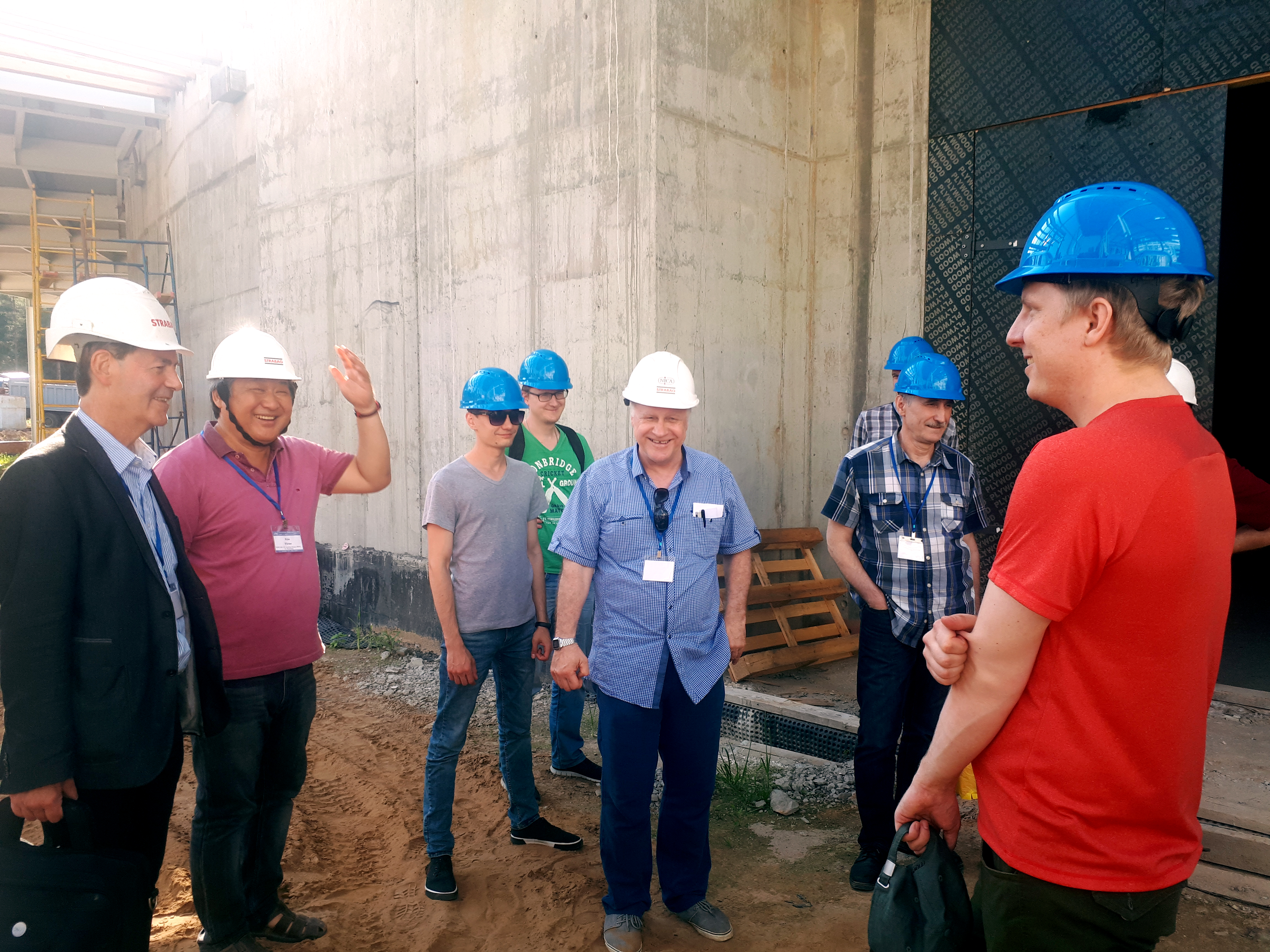Spin Physics at the NICA Collider
News, 24 June 2019
On 5 – 7 June 2019, the International Workshop “SPD at NICA-2019” was held in the Laboratory of High Energy Physics of the Joint Institute for Nuclear Research. The Workshop was dedicated to the theory and the experiment in the fields of spin physics at the SPD facility, one of two large-scale facilities at the NICA collider being constructed, as well as to the establishment of the SPD international collaboration.
125 scientists from Russia, Armenia, Belarus, Bulgaria, China, the Czech Republic, Cuba, France, Germany, Italy, Poland, Slovakia, Switzerland, and Ukraine took part in the Workshop. Moreover, a large number of staff members and guests of JINR visited the Workshop. About 50 reports were presented.
Project Coordinator, VBLHEP Deputy Director Rumen Tsenov reported on the current status, compared SPD with other facilities, and considered theoretical ideas the project is based on. Unique opportunities of the SPD experiment making it attractive and competitive are determined by, first of all, a wide range of polarized beams of interacting protons, deuterons, and their combinations as well. Moreover, a possibility to conduct experiments with interactions of longitudinally and transversely polarized protons and deuterons with light nuclei is considered. A possibility to perform energy scan with small steps over the collision energy of NICA allows conducting a precise study of the transition energy range that is more complicated in terms of the theoretical description.
According to the plans, the SPD Conceptual Design Report will be prepared by the end of 2019. The SPD collaboration will be established next year. Development of the technical projects will take about two years, and then, in three years, the SPD facility will be built. Thus, the first measurement in the SPD experiment can be expected not later than the end of 2025.
The programme of the Workshop was very rich and practical. The first day was dedicated to the theory of spin and polarization phenomena. Experimental conditions of the SPD facility at the NICA collider allow studying the spin structure of hadrons, creating parton distribution functions, studying the spin effects in processes of nuclear matter production, diffraction processes, multiquark states, production of direct photons, Drell-Yan processes as well as the J/ψ production by tensor-polarized deuterons. The existing high level of theoretical approaches in the field demands precise experimental data for a deeper understanding of the structure and properties of nuclear matter.
Presented at the meeting reports gave a comprehensive overview of the current situation in the fields of research on polarization phenomena, outlined existing problems and unsolved tasks. Participants also discussed research that is conducted or has been concluded and proposals for future research in relevant fields in such laboratories as JLab (CEBAF), CERN (COMPASS, COMPASS++/AMBER, ALICE) and others.
It should be noted that experimentalists made a traditional address to theoreticians and developers of the subsystems of the SPD facility to formulate theoretical constructions in the language of measurable parameters and values specifying needed precision of their measurement.
On the second and the third days, most of the attention was drawn to developed and planned subsystems of the SPD facility, detector systems for the physical experiment as well as test and control of beam parameters.
A report on major SPD subsystems was delivered that considered the Data Acquisition System, Electromagnetic and Hadron Calorimeters, muon system, Central Tracker, production and measurement of polarized beams, polarimetry at NICA, development of the Vertex Detector, particle identification systems, etc. The expertise acquired at existing facilities with a close physical programme was also reported on, that is no doubt, important for drafting a detailed concept of the SPD experiment and its equipment.
Participants of the Workshop considered the issue of construction of the SPD test zone at extracted and secondary beams of the Nuclotron-M for testing detectors and the electronic data acquisition system, as well as training of young highly-qualified specialists. Thus, for example, the team from Belgrade University has been already engaged in the project and now produces vacuum chambers and the ion guide for the SPD test zone. The team from St. Petersburg University with the support of RFBR develops prototypes of small-angle beam scattering detectors based on microchannel plates.
A report by a representative of Tsinghua University (Beijing) Yi Wang on the experience in the creation of the RPC detector for various international physical centres should be highlighted. The RPC is possibly one of the best technologies used in, for example, Time-of-Flight systems of the STAR (RHIC) and the CBM (FAIR). It has a very high time resolution (up to 20 ps). Scientists from ITEP and IHEP made alternative proposals for the creation of Time-of-Flight systems for identification of hadrons based on the RPC detectors. Thus, there is an opportunity to choose the best option for the creation of large-scale expensive detectors for the SPD facility.
Round tables were very informative. Participants on behalf of their organizations showed their interest and readiness to be engaged in the SPD collaboration.
Nowadays, about 30 organizations from 10 countries expressed their interest in the creation of SPD, 12 of them had already issued their letters of intent. Protocols for bilateral cooperation in the frames of the project were signed with five organizations.
The fact that possibly the most active participants of the established collaboration are universities of Belgrade, Gomel, Moscow, Prague, Samara, St. Petersburg, Tomsk, Torino, and Warsaw is very telling. It guarantees that such complex and expensive research facilities as NICA and SPD will definitely serve to science and training of deserving successors. It is a pleasure that Dubna University also took part. The meeting was attended by Rector of Dubna University D. V. Fursaev and Prorector for Research and Innovation Yu. A. Krukov. Thus, young people studying at Dubna University will be able to use scientific opportunities of the new NICA Centre that is under construction.
The key issue of the third day of the Workshop was to define the rules of future collaboration and to choose the editorial committee for the development of the collaboration’s constitution. Prof. O. Dalkarov (Lebedev Physical Institute) was elected as Chairman of the editorial committee. Representatives of eight other organizations from five countries were also elected to the committee.
On the last day of the Workshop, participants visited the NICA construction site and the production area of the magnet elements for FAIR and NICA in the VBLHEP JINR territory. Only after seeing the construction site with one’s own eyes, one can feel the scale of the construction.
Participants of the Workshop had a lot to discuss. Discussions took place all the time: in breaks between reports, at round tables, even during the excursions.
Scientists are confident that the result of the Workshop will be uniting of interested teams from various scientific and educational organizations into an efficient collaboration able to draft and then perfectly conduct research in this fascinating field of physics at the SPD facility.
On behalf of the SPD collaboration
E. G. Baldina
Photos by A. A. Baldin
Translated by A. Yu. Chigireva

